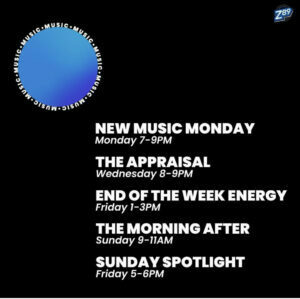Brian Eno & Beatie Wolfe on Broadcasting Their New Ambient Album Into Space: ‘It Felt Fitting’
The creative process that Brian Eno and Beatie Wolfe carved out while making their trio of ambient albums was — perhaps surprisingly, given what they’d ultimately record — deeply normal.
Wolfe would leave her London flat by bike, ride through the park and, ten minutes later, arrive at Eno’s studio. Here the pair would hash out music on a guitar Eno acquired in 1981. If they needed an instrument they didn’t have on hand, they’d walk to the nearest pawn shop and find it.
“There were no private jets,” Wolfe says with a laugh.
From such quotidian origins has come a trinity of ambient albums: Lateral and Luminal, both released in June, and Liminal, out Oct. 10. All released on Verve Records, the projects expand Eno’s work in the ambient realm — a genre he effectively created in 1970s — and summon such deep feelings in their makers that Wolfe and Eno issued a list of emotions experienced during the creation process. (These include “ailyak,” a Bulgarian term for going slow and enjoying the process, “feath,” Gaelic for stillness and peace, and “ilinx,” French for a strange excitement from play.)
Creating work of great depth out of fairly ordinary means was not the goal. Eno emphasizes that in fact there was no goal at all, which might be why the process generated such rich results.
“The way I work in the studio when I’m on my own is a combination of absolute blind fiddling about, just walking in and saying, ‘Well, I better start doing something, because I’ve got this studio’ and then paying a lot of attention to the moment something starts to happen,” says Eno. “In a way, it depends on being goalless, and I’ve found it’s very hard to find other people who can work in that way… Beatie and I were both very reassured to be working with somebody else [with the same process].”
But while the two share this creation-for-creation’s-sake approach, their respective careers are also defined by lofty ambitions that bridge the worlds of music, visual art and science and beyond. Eno is the revered activist, artist and producer whose own work and whose work with with artists like David Bowie and U2 helped define the sound of modern pop and rock music. Wolfe is the multidisciplinary artist whose work explores topics related to climate, the effects of music on dementia and much more.
As such, it’s apt, if still fantastical, that two people who gathered instruments in pawn shops together are now beaming the music they made on those instruments into space.
On Wednesday, Oct. 15, Wolfe and Eno will broadcast the entirety of Liminal into the cosmos, using the Holmdel Horn Antenna, a 50-foot tall machine that proved evidence of the Big Bang in 1964. Nobel Prize winning physicist Dr. Robert Wilson will use Holmdel Horn Antenna (a designated National Historic Landmark since 1989) to transmit the music from its site in Crawford Hill, New Jersey.
“This music, to us, feels like an exploration of new territories, imagining future worlds that we want to live in,” says Eno, “and so it felt fitting to broadcast it into the unknown, into dark matter.”
It’s heady stuff that considers both the most intimate parts of the internal landscape and the furthest realms of the universe, and you can join too. The broadcast will also be livestreamed around the world via this link, with Eno, Wolfe and Dr. Wilson all joining the stream to give remarks on the project. The stream begins at 5:45 p.m. ET, with the horn moved into space broadcasting orientation at 6 p.m. before the broadcast begins at sunset. The livestream will end at 6:30 p.m. ET, while the broadcast continues on the ground and among the stars.
The Antenna site will also host a listening party for the local community and campaigners who saved the area from real estate developers in 2023. These efforts made it so the Horn Antenna now sits on the 35-acre Dr. Robert Wilson Park, one of the newest parks in the United States and one that honors Wilson, who won the Nobel Prize in 1978 for his co-discovery of cosmic microwave background radiation.
“This experiment in art and technology continues a long history of scientists and artists — John Cage, Robert Rauschenberg, Andy Warhol — working together to unite the fields and learn from one another,” says Wolfe.

Holmdel Horn Antenna
Courtesy of Bell Labs
The space broadcast creates more of the connective tissue linking each project in Eno and Wolfe’s own work, and linking their careers as well. The two met via EarthPercent, the organization Eno co-launched in 2021, which distributes donated portions of musicians’ income to environmental causes. The two first connected on Zoom and then at SXSW 2022, where they spoke about how art can play a role in responding to the climate emergency. Finding “a very natural connection,” says Wolfe, they later convened in the studio.
“In the beginning it was just playing around with software and this very sad, out-of-tune ukulele Brian has in his studio that’s probably never had any loving handling before,” jokes Wolfe. “We made two pieces of music quite spontaneously, and it was really fun.”
So fun that they carried on working, eventually amassing 450 pieces of music. They were especially compelled by the complex feelings the music elicited for each of them while they were making it, and they thought others might enjoy entering this space of emotional conjuring as well.
“I think we find our way into the future by letting ourselves have feelings about things,” says Eno, who over Zoom is, like Wolfe, warm, funny and deeply thoughtful. “If it’s art, you can have all sorts of feelings, and you’re not harmed by them, because you can switch them off. Through art, you’re allowed to let yourself experience new feelings and see how they feel to you and to therefore be able to talk about them with other people. So art is a way of creating feelings, but it’s also a way of making feelings public and discussable among people.”
Certainly the music isn’t telling anyone how to feel, just offering a space that might make them feel something. But, given the gentle, spatial, simultaneously simple and layered productions on the three albums, one does experience the music as a sort of nervous system salve in a noisy world.
“So much information is just trying to cut above that constant noise,” says Wolfe. “So then it has to get more compressed, louder, edgier and ultimately more stressful. So to make things quiet, but quiet and still voluminous, I think is really needed right now.”
“Because otherwise,” she continues, “I think we’re so often responding in a kind of fight-or-flight mode, because we’re so disturbed, and then equally you need things that are more and more shocking to elicit any response. I think it’s revolutionary to do the opposite.”
“We’re in the context of the biggest industry in the world, advertising, that desperately wants to tell you what it is that you like, what you should like and what other people like,” adds Eno. “Then we’re in the midst of another industry, corporate politics, which is what I call modern democracy, which tells you who you should like, who you should vote for, what you want them to do. There’s a flood of stuff hitting us all the time… I think art is one of the primary ways of saying, ‘Hold on, what do I actually like? What really affects me. What are the feelings I want to have?’”
Or, has he says with a laugh while putting it more bluntly, “You just think, ‘Shut the f–k up, please. Please!’ That’s why I always feel that when I walk into a noisy restaurant in New York, I want to issue an edict and say ‘Please all of you, shut up. Start again from silence.”

Beatie Wolfe & Brian Eno
Cecily Eno
Luminal, Lateral and Liminal encourage this return to baseline, and in doing so extend the music into the artistic, scientific, emotional and intellectual ecosystems in which each artist’s work resides. The space broadcast is thus an apt component, as it fuses music with science, activism, nature and the great unknown.
“Neurologist Oliver Sacks said there are two things we really need to safeguard for in order to be sentient beings on this planet, and they are art and nature,” says Wolfe. “Those are the two things that keep us alive inside. That’s what I’m always thinking about, how do you remind people of the value of art and nature, which seems so obvious but have gotten lost in the fast-tracking of everything else.”
As such, the albums and space broadcast fit into each artists’ endeavors to protect the planet and wake humanity up to the fact that the fate of the world relies on our actions. Engendering these considerations through the new music makes it both an act of hope and a rallying cry rendered in soft synths.
“I think we’re in the biggest social movement in the history of humankind,” says Eno, “which is a movement that says, ‘Hold on, we’re part of this planet; we’re part of each other; we’re part of all the other things that live here. We’re not the most important part. We’re just the part we pay most attention to.’ It’s so important that we start to get that message. When you have mental illnesses like Donald Trump telling us that it doesn’t matter, that it’s all a big hoax and ‘drill baby, drill’ — that’s the old world. We just have to just start saying to them, ‘Yes, fine. Go and ramble on about your stupid f—king coal mines. We’ve got other things to do now.’”
While each are busy people — Eno joins the conversation right after speaking in front of a crowd of thousands during an Oct. 11 pro-Palestine march in London, from a studio where he’s about to work on a series of paintings with Bette Adriaanse, his co-writer on the book 2025 book What Art Does: An Unfinished Theory, while Wolfe is continuing on in her own myriad endeavors — they reveal that they’re already working on another collaborative project. To keep it coming makes sense not only because of how much music they’ve created, but because of the interesting things it does for each them and what they think it might do for others — which isn’t one thing in particular, but just something at all.
“I think this kind of art makes you want to quietly be happy with what you’ve got,” Eno says. “It’s not telling you that you should have a different life, that you should be something else. It’s telling you to settle down and see where you are, see what you feel, and to accept the feelings that come come up from it. I don’t want to tell people what they should do. I want to offer them somewhere they could, not should, go. ‘Here’s a set of feelings you could have. What do you think about them?’ If you hate them, then you’ve learned something. But if you love them, you might want to change your life a little bit so that it has more of those feelings in it.”
The ideas of reflection and gratitude are refreshing in a world that’s constantly demanding we do more, be more, want more. Sometimes, the music ultimately reminds, its okay to just be creative with a friend, ride your bike through the park, look to the stars.
Powered by Billboard.

